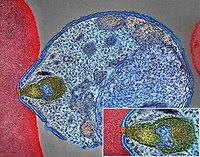
Photo from wikipedia
BackgroundCurrently in China, the trend of Plasmodium vivax cases imported from Southeast Asia was increased especially in the China-Myanmar border area. Driven by the increase in P. vivax cases and… Click to show full abstract
BackgroundCurrently in China, the trend of Plasmodium vivax cases imported from Southeast Asia was increased especially in the China-Myanmar border area. Driven by the increase in P. vivax cases and stronger need for vaccine and drug development, several P. vivax isolates genome sequencing projects are underway. However, little is known about the genetic variability in this area until now.ResultsThe sequencing of the first P. vivax isolate from China-Myanmar border area (CMB-1) generated 120 million paired-end reads. A percentage of 10.6 of the quality-evaluated reads were aligned onto 99.9% of the reference strain Sal I genome in 62-fold coverage with an average of 4.8 SNPs per kb. We present a 539-SNP marker data set for P. vivax that can identify different parasites from different geographic origins with high sensitivity. We also identified exceptionally high levels of genetic variability in members of multigene families such as RBP, SERA, vir, MSP3 and AP2. The de-novo assembly yielded a database composed of 8,409 contigs with N50 lengths of 6.6 kb and revealed 661 novel predicted genes including 78 vir genes, suggesting a greater functional variation in P. vivax from this area.ConclusionOur result contributes to a better understanding of P. vivax genetic variation, and provides a fundamental basis for the geographic differentiation of vivax malaria from China-Myanmar border area using a direct sequencing approach without leukocyte depletion. This novel sequencing method can be used as an essential tool for the genomic research of P. vivax in the near future.
Journal Title: BMC Genomics
Year Published: 2017
Link to full text (if available)
Share on Social Media: Sign Up to like & get
recommendations!